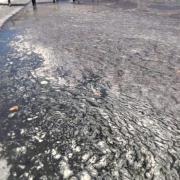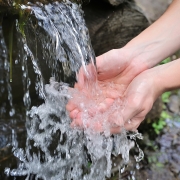Summer Blooms Loom
Summer Blooms Loom
Mid-summer conditions have not been kind to much of the already impaired 160-mile-long Indian River Lagoon (IRL). That’s been the case for the past two decades especially, as rain-induced stormwater and ground water runoff carries in copious amounts of nitrogen, phosphorus, sediment and herbicides that are at the root of cyanobacteria blooms and other planktonic blooms.
And it does not help that shoreline development with impervious surfaces are still permitted in many areas.
The worst blooms in the past year have occurred from Melbourne north in the Lagoon, and in the extreme southern IRL we have been fortunate thus far to not have Lake Okeechobee discharges which can turn the St. Lucie River fresh and even usher in toxic microcystis with blue-green surface mats.
Luckily, a long dry season this spring and early summer has allowed the big Lake to recede to manageable levels (12.6 foot elevation as of mid-June) so far it’s spared the St. Lucie of damaging Lake discharges. This luck may run out though should heavy tropical rains arrive and bring the Lake back up to the 15-foot mark anytime after August 1.
The Best Lake Okeechobee Plan for Coastal Estuaries
The Army Corps (USACE) will have released its “preferred plan” under LOSOM (Lake Okeechobee Systems Operation Manual) for Lake Okeechobee management and water distribution on June 29, and residents, waterfront businesses owners and IRK members are encouraged to keep track of the Corps’ public comment periods prior to and after that date.
The public can make comment prior to that date, get email link via U.S. Army Corp’s website here https://www.saj.usace.army. mil/LOSOM/
Of literally thousands of water management models and 5 final iterations, the Corps has narrowed it down to plans AA, BB, CC, DD and EE. Each plan has its “winners and losers” so far as balance (harm versus benefit) of the Lake’s fresh water distribution is concerned, and Indian Riverkeeper has repeatedly stressed to the Corps that the St. Lucie River and lower IRL gets no benefit, and only harm, from releases from the Lake to the estuary.
Therefore, we strongly support plan CC which eliminates the need for the Lake discharges, and we will also push for changes to that plan, such as the elimination of Lake discharges to the Lake Worth Lagoon.
The City of Stuart and Martin County also supports plan CC, and endorses the June 1, 2021 letter sent by Congressman Brian Mast, Congressman Byron Donalds, and other east and west coast stakeholders to USACE regarding Plan CC from Iteration 2 of LOSOM. The City further concurs with its stakeholder partners that utilizing Plan CC as a baseline upon which to improve relevant performance metrics would benefit the most amount of parties while doing the least amount of harm.
“Local” Blooms in Treasure Coast Waters
While watching the LOSOM process with Lake Okeechobee, we are monitoring and documenting a troubling bloom of a Cyanobacteria known as Lyngbya.
Lagoon-side residents south from Ft. Pierce to Jensen reported it to Indian Riverkeeper in mid-May and it has persisted, in some places forming odorous drying mats in the shallows and on the shorelines of the IRL. Much of it originates on the bottom, over shallow flats that have seen a decline in native seagrasses such as manatee and shoal grass. In time, the Cyanobacteria floats to the surface in grey, brown and black clumps and is carried by tide and wind until it reaches dry land.
A common type here in the IRL and elsewhere in Florida coastal waters is Lyngbya majuscula. The blooms flourish under rising water temperatures and increasing inputs of nitrogen, iron and phosphorus— common nutrients found in septic seepage, sewage, groundwater and yard fertilizers. The blooms form in sediments and can eventually crowd out seagrasses. The blooms photosynthesize rapidly and produce oxygen that is trapped in its own filaments, and it rises to the surface and floats. This is when it accumulates, decomposes and smells badly.
If the blooms are extensive, they can smother bottom habitats, including seagrasses, which are already low in number in much of the IRL. Chronic Lyngbya blooms can even cause seagrass stress and die offs by restricting light availability.
The only way to decrease such impacts is to reduce our nutrient inputs into the IRL. Many Florida counties and cities have established voluntary fertilizer bans during the wet months of June through October because that is when rainfall carries nutrients into water bodies. Residents are asked to comply with the bans, pick up pet waste, especially near the IRL, keep grass clippings from entering waterways, inspect septic systems regularly, or better yet, convert to sewage systems where feasible.
If you see what you suspect is a Lyngbya or other potentially harmful Algal bloom, call the Florida DEP at 855-305-3903 and call Director Mike Conner, cell 772-521-1882.


